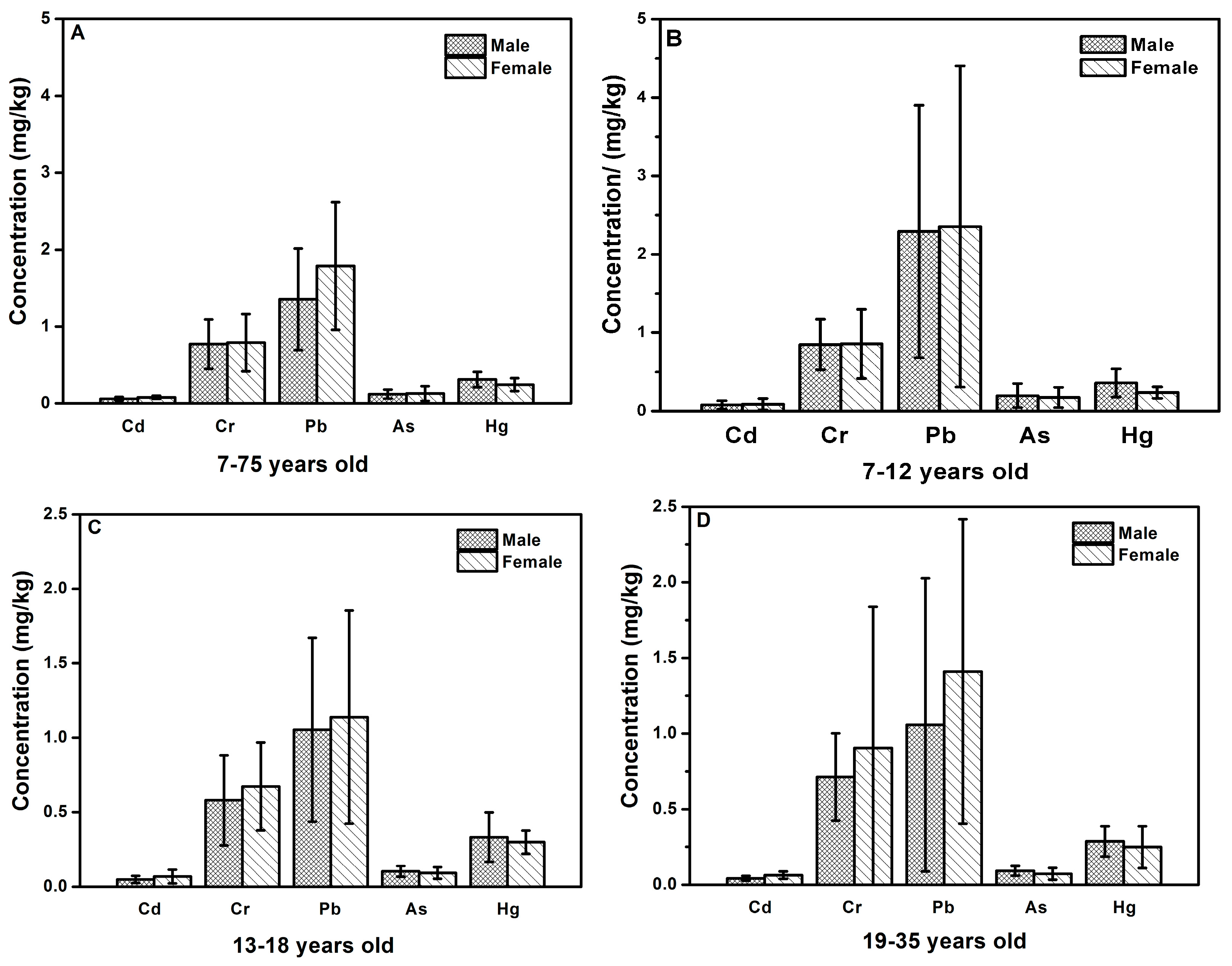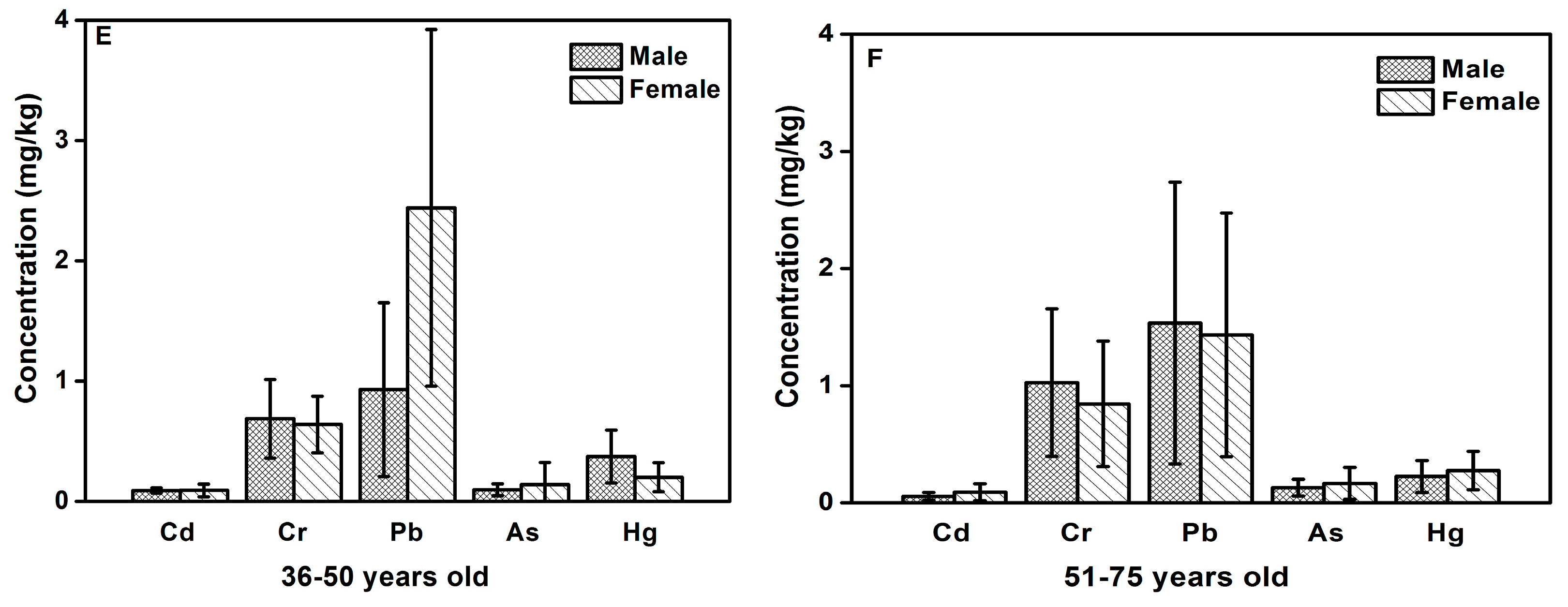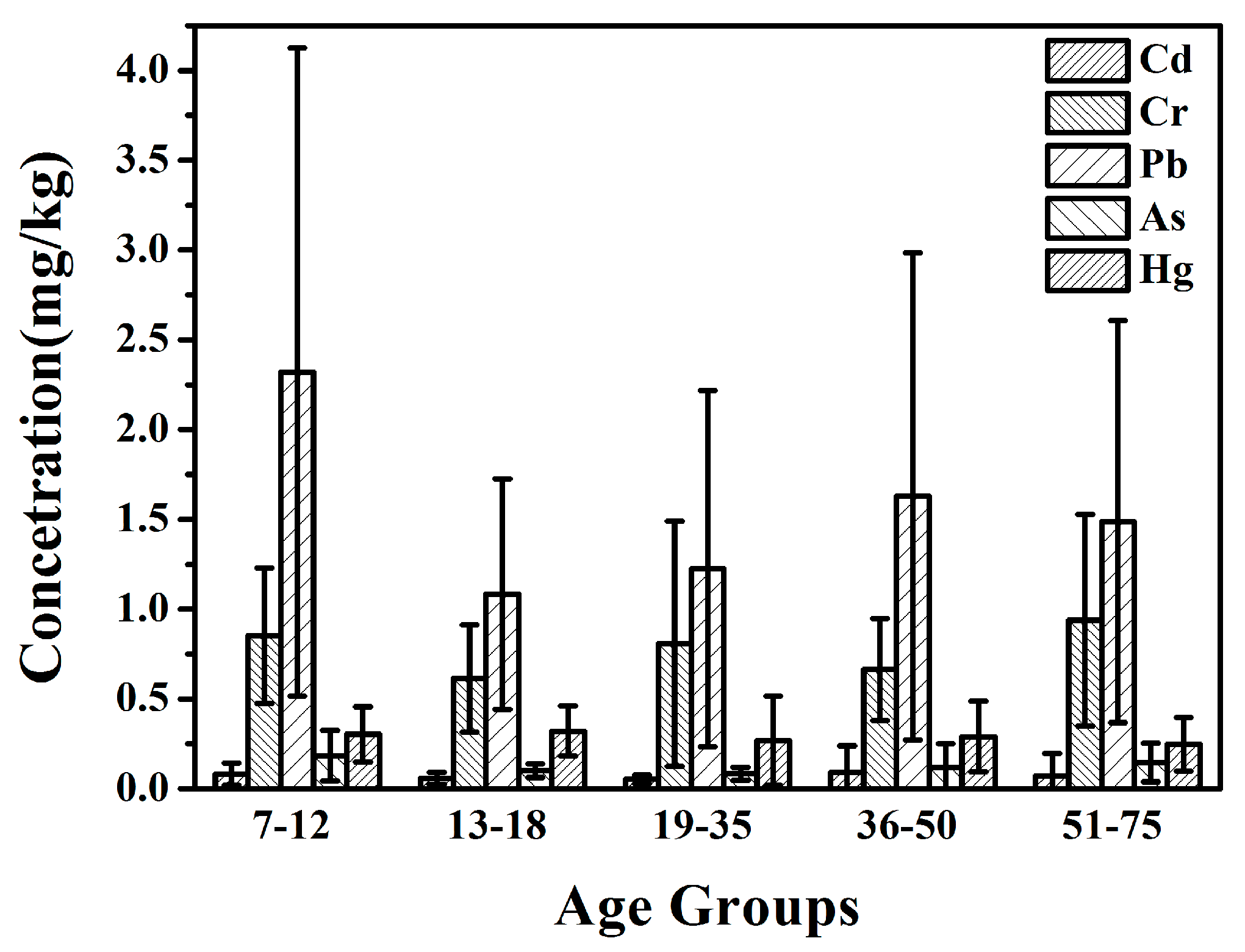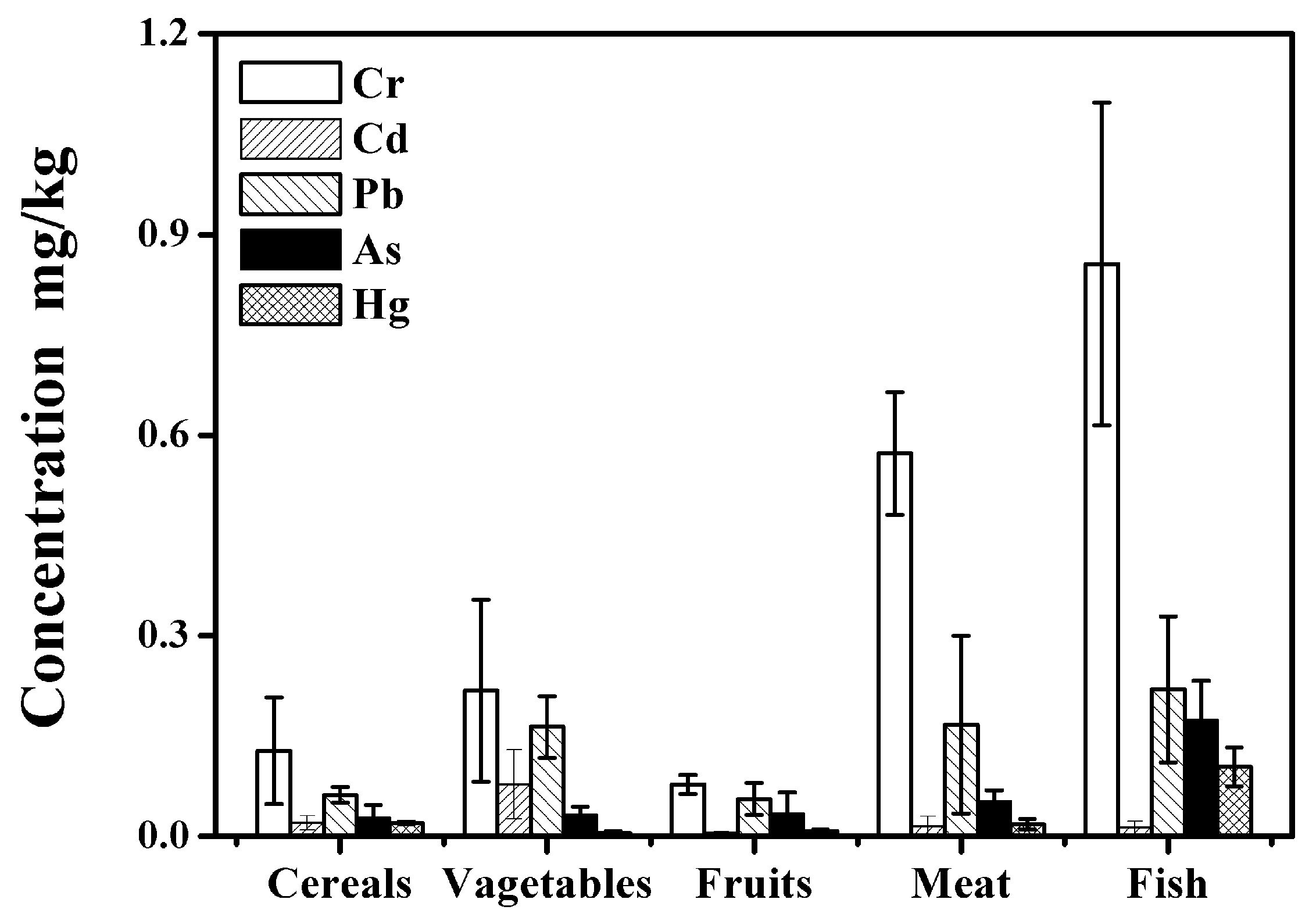Assessment of Typical Heavy Metals in Human Hair of Different Age Groups and Foodstuffs in Beijing, China
Abstract
:1. Introduction
2. Experiment
2.1. Sample Collection
2.2. Chemicals and Materials
2.3. Sample Pre-Treatment
2.4. Analytical Methods
2.5. Quality Assurance and Control
2.6. Statistical Analysis
3. Results and Discussion
3.1. Average Concentrations of Heavy Metals in Hair Samples
3.2. Heavy Metal Concentrations in Human Hair of Different Gender and Age Groups
3.3. Health Risks of Heavy Metal Intakes, and Relationship with Hair Metal Concentrations
4. Conclusions
Acknowledgments
Author Contributions
Conflicts of Interest
References
- Gonzalez-Munoz, M.J.; Pena, A.; Meseguer, I. Monitoring heavy metal contents in food and hair in a sample of young Spanish subjects. Food Chem. Toxicol. 2008, 46, 3048–3052. [Google Scholar] [CrossRef] [PubMed]
- Song, B.; Zeng, G.; Gong, J.; Liang, J.; Xu, P.; Liu, Z.; Zhang, Y.; Zhang, C.; Cheng, M.; Liu, Y.; et al. Evaluation methods for assessing effectiveness of in situ remediation of soil and sediment contaminated with organic pollutants and heavy metals. Environ. Int. 2017, 105, 43–55. [Google Scholar] [CrossRef] [PubMed]
- Song, B.; Zeng, G.; Gong, J.; Zhang, P.; Deng, J.; Deng, C.; Yan, J.; Xu, P.; Lai, C.; Zhang, C.; et al. Effect of multi-walled carbon nanotubes on phytotoxicity of sediments contaminated by phenanthrene and cadmium. Chemosphere 2017, 172, 449–458. [Google Scholar] [CrossRef] [PubMed]
- Liu, G.; Tao, L.; Liu, X.; Hou, J.; Wang, A.; Li, R. Heavy metal speciation and pollution of agricultural soils along Jishui River in non-ferrous metal mine area in Jiangxi Province, China. J. Geochem. Explor. 2013, 132, 156–163. [Google Scholar] [CrossRef]
- Apostoli, P. Elements in environmental and occupational medicine. J. Chromatogr. B 2002, 778, 63–97. [Google Scholar] [CrossRef]
- Kaewsarn, P.; Yu, Q.M. Cadmium (II) removal from aqueous solutions by pre-treated biomass of marine alga Padina sp. Environ. Pollut. 2001, 112, 209–213. [Google Scholar] [CrossRef]
- Nies, D.H. Microbial heavy-metal resistance. Appl. Microbiol. Biot. 1999, 51, 730–750. [Google Scholar] [CrossRef]
- Chan, S.M.; Wang, W.X.; Ni, I.H. The uptake of Cd, Cr, and Zn by the macroalga enteromorpha crinita and subsequent transfer to the marine herbivorous rabbitfish, siganus. Arch. Environ. Contam. Toxicol. 2003, 44, 298–306. [Google Scholar] [CrossRef] [PubMed]
- Gao, Y.; Shi, Z.M.; Long, Z.; Wu, P.; Zheng, C.B.; Hou, X.D. Determination and speciation of mercury in environmental and biological samples by analytical atomic spectrometry. Microchem. J. 2012, 103, 1–14. [Google Scholar] [CrossRef]
- Järup, L. Hazards of heavy metal contamination. Br. Med. Bull. 2003, 68, 167–182. [Google Scholar] [CrossRef] [PubMed]
- Horiguchi, H.; Teranishi, H.; Niiya, K.; Aoshima, K.; Katoh, T.; Sakuragawa, N.; Kasuya, M. Hypoproduction of erythropoietin contributes to anemia in chronic cadmium intoxication: Clinical study on Itai-itai disease in Japan. Arch. Toxicol. 1994, 68, 632–636. [Google Scholar] [CrossRef] [PubMed]
- Liu, G.; Yu, Y.; Hou, J.; Xue, W.; Liu, X.; Liu, Y.; Wang, W.; Alsaedi, A.; Hayat, T.; Liu, Z. An ecological risk assessment of heavy metal pollution of the agricultural ecosystem near a lead-acid battery factory. Ecol. Indic. 2014, 47, 210–218. [Google Scholar] [CrossRef]
- Zhuang, P.; McBride, M.B.; Xia, H.; Li, N.; Li, Z. Health risk from heavy metals via consumption of food crops in the vicinity of Dabaoshan mine, South China. Sci. Total Environ. 2009, 407, 1551–1561. [Google Scholar] [CrossRef] [PubMed]
- Srogi, K. Hair analysis for monitoring environmental pollution and the resulting human exposure to trace metals: An overview. Environ. Risque Santé 2006, 5, 391–405. [Google Scholar]
- Harkins, D.K.; Susten, A.S. Hair analysis: Exploring the state of the science. Environ. Health Perspect. 2003, 111, 576–578. [Google Scholar] [CrossRef] [PubMed]
- Agusa, T.; Kunito, T.; Iwata, H.; Monirith, I.; Tana, T.S.; Subramanian, A.; Tanabe, S. Mercury contamination in human hair and fish from Cambodia: Levels, specific accumulation and risk assessment. Environ. Pollut. 2005, 134, 79–86. [Google Scholar] [CrossRef] [PubMed]
- Rashed, M.N.; Hossam, F. Heavy metals in fingernails and scalp hair of children, adults and workers from environmentally exposed areas at Aswan. Egypt. Environ. Bioindic. 2007, 2, 131–145. [Google Scholar] [CrossRef]
- Chojnacka, K.; Górecka, H.; Chojnacki, A.; Górecki, H. Inter-element interactions in human hair. Environ. Toxicol. Pharmacol. 2005, 20, 368–374. [Google Scholar] [CrossRef] [PubMed]
- Morton, J.; Carolan, V.A.; Gardiner, P.H.E. Removal of exogenously bound elements from human hair by various washing procedures and determination by inductively coupled plasma mass spectrometry. Anal. Chim. Acta 2002, 455, 23–34. [Google Scholar] [CrossRef]
- Teresa, M.; Vasconcelos, S.D.; Tavares, H.M.F. Trace element concentrations in blood and hair of young apprentices of a technical-professional school. Sci. Total Environ. 1997, 205, 189–199. [Google Scholar] [CrossRef]
- Sera, K.; Futatsugawa, S.; Murao, S. Quantitative analysis of untreated hair samples for monitoring human exposure to heavy metals. Nucl. Instrum. Methods B 2002, 189, 174–179. [Google Scholar] [CrossRef]
- Olmedo, P.; Pla, A.; Hernández, A.F.; López-Guarnido, O.; Rodrigo, L.; Gil, F. Validation of a method to quantify chromium, cadmium, manganese, nickel and lead in human whole blood, urine, saliva and hair samples by electrothermal atomic absorption spectrometry. Anal. Chim. Acta 2010, 659, 60–67. [Google Scholar] [CrossRef] [PubMed]
- Goullé, J.P.; Loïc, M.; Julien, C.; Nicolas, N.; Laurent, B.; Gilbert, L.; Daniel, B.; Christian, L. Metal and metalloid multi-elementary ICP-MS validation in whole blood, plasma, urine and hair: Reference values. Forensic Sci. Int. 2005, 153, 39–44. [Google Scholar] [CrossRef] [PubMed]
- Esteban, M.; Castaño, A. Non-invasive matrices in human biomonitoring: A review. Environ. Int. 2009, 35, 438–449. [Google Scholar] [CrossRef] [PubMed]
- Doğan-Sağlamtimur, N.; Kumbur, H. Metals (Hg, Pb, Cu, and Zn) bioaccumulation in sediment, fish, and human scalp hair: A case study from the city of Mersin along the southern coast of Turkey. Biol. Trace Elem. Res. 2010, 136, 55–70. [Google Scholar] [CrossRef] [PubMed]
- Ferré-Huguet, N.; Nadal, M.; Schuhmacher, M.; Domingo, J.L. Monitoring metals in blood and hair of the population living near a hazardous waste incinerator: Temporal trend. Biol. Trace Elem. Res. 2009, 128, 191–199. [Google Scholar] [CrossRef] [PubMed]
- Wang, T.; Fu, J.; Wang, Y.W.; Liao, C.Y.; Tao, Y.Q.; Jiang, G.B. Use of scalp hair as indicator of human exposure to heavy metals in an electronic waste recycling area. Environ. Pollut. 2009, 157, 2445–2451. [Google Scholar] [CrossRef] [PubMed]
- Pereira, R.; Ribeiro, R.; Goncalves, F. Scalp hair analysis as a tool in assessing human exposure to heavy metals (S. Domingos mine, Portugal). Sci. Total Environ. 2004, 327, 81–92. [Google Scholar] [CrossRef] [PubMed]
- Caroli, S.; Alimonti, A.; Coni, E.; Petrucci, F.; Senofonte, O.; Violante, N. The assessment of reference values for elements in human biological tissues and fluids: A systematic review. Crit. Rev. Anal. Chem. 1994, 24, 363–398. [Google Scholar] [CrossRef]
- Sreenivasa, R.K.; Balaji, T.; Prasada, R.T.; Babu, Y.; Naidu, G. Determination of iron, cobalt, nickel, manganese, zinc, copper, cadmium and lead in human hair by inductively coupled plasma-atomic emission spectrometry. Spectrochim. Acta B 2002, 57, 1333–1338. [Google Scholar] [CrossRef]
- Türkdoan, M.K.; Kilicel, F.; Kara, K.; Tuncer, I.; Uygan, I. Heavy metals in soil, vegetables and fruits in the endemic upper gastrointestinal cancer region of Turkey. Environ. Toxicol. Pharmacol. 2003, 13, 175–179. [Google Scholar] [CrossRef]
- Türkmen, A.; Türkmen, M.; Tepe, Y.; Akyurt, I. Heavy metals in three commercially valuable fish species from Iskenderun Bay, Northern East Mediterranean Sea, Turkey. Food Chem. 2005, 91, 167–172. [Google Scholar] [CrossRef]
- Mora, M.A. Heavy metals and metalloids in egg contents and eggshells of passerine birds from Arizona. Environ. Pollut. 2003, 125, 393–400. [Google Scholar] [CrossRef]
- Qin, J.F. The upper limit of normal value of Hair Pb, Cd, As, Hg in Chinese resident. Trace Elem. Sci. 2004, 11, 29–37. [Google Scholar]
- Rodushkin, I.; Axelsson, M.D. Application of double focusing sector field ICP-MS for multielemental characterization of human hair and nails. Part II. A study of the inhabitants of northern Sweden. Sci. Total Environ. 2000, 262, 21–36. [Google Scholar] [CrossRef]
- Senofonte, O.; Violante, N.; Caroli, S. Assessment of reference values for elements in human hair of urban schoolboys. J. Trace Elem. Med. Biol. 2000, 14, 6–13. [Google Scholar] [CrossRef]
- Miekeley, N.; Dias Carneiro, M.; da Silveira, C.L.P. How reliable are human hair reference intervals for trace elements? Sci. Total Environ. 1998, 218, 9–17. [Google Scholar] [CrossRef]
- Samanta, G.; Sharma, R.; Roychowdhury, T.; Chakraborti, D. Arsenic and other elements in hair, nails, and skin-scales of arsenic victims in West Bengal, India. Sci. Total Environ. 2004, 326, 33–47. [Google Scholar] [CrossRef] [PubMed]
- Hajeb, P.; Selamat, J.; Ismail, A.; Bakar, F.A.; Bakar, J.; Lioe, H.N. Hair mercury level of coastal communities in Malaysia: A linkage with fish consumption. Eur. Food Res. Technol. 2008, 227, 1349–1355. [Google Scholar] [CrossRef] [Green Version]
- Wang, X.; Sato, T.; Xing, B.; Tao, S. Health risks of heavy metals to the general public in Tianjin, China via consumption of vegetables and fish. Sci. Total Environ. 2005, 350, 28–37. [Google Scholar] [CrossRef] [PubMed]
- Mortada, W.I.; Sobh, M.A.; El-Defrawy, M.M.; Farahat, S.E. Reference intervals of cadmium, lead, and mercury in blood, urine, hair, and nails among residents in Mansoura city, Nile Delta, Egypt. Environ. Res. 2002, 90, 104–110. [Google Scholar] [CrossRef] [PubMed]
- Ashraf, W.; Jaffar, M.; Anwer, K.; Ehsan, U. Age-and sex-based comparative distribution of selected metals in the scalp hair of an urban population from two cities in Pakistan. Environ. Pollut. 1995, 87, 61–64. [Google Scholar] [CrossRef]
- Khalique, A.; Ahmad, S.; Anjum, T.; Jaffar, M.; Shah, M.H.; Shaheen, N.; Tariq, S.R.; Manzoor, S.A. Comparative study based on gender and age dependence of selected metals in scalp hair. Environ. Monit. Assess. 2005, 104, 45–57. [Google Scholar] [CrossRef] [PubMed]
- Li, Z.B.; Wang, Q.C.; Luo, Y.M. Exposure of the urban population to mercury in Changchun city, Northeast China. Environ. Geochem. Health 2006, 28, 61–66. [Google Scholar] [CrossRef] [PubMed]
- Zhai, F.Y.; He, Y.N.; Ma, G.S.; Li, Y.P.; Wang, Z.H.; Hu, Y.S.; Zhao, L.Y.; Cui, Z.H.; Li, Y.; Yang, X.G. Study on the current status and trend of food consumption among Chinese population. Chin. J. Epidemiol. 2005, 26, 485–488. [Google Scholar]
- World Health Organization. Evaluation of Certain Food Additives and Contaminants; World Health Organization: Geneva, Switzerland, 1993. [Google Scholar]




| Metals | Mean Values (mg/kg) | Range (mg/kg) | Published Range (mg/kg) [35] |
|---|---|---|---|
| Cd | 0.071 ± 0.032 | 0.02–0.96 | 0.02–16 |
| Cr | 0.782 ± 0.394 | 0.05–4.54 | 0.03–33 |
| Pb | 1.557 ± 0.779 | 0.17–6.65 | 0.004–95 |
| As | 0.127 ± 0.078 | 0.03–0.87 | 0.015–26 |
| Hg | 0.284 ± 0.094 | 0.04–0.87 | 0.07–106 |
| Country | Cd | Cr | Pb | As | Hg | Reference |
|---|---|---|---|---|---|---|
| Poland | 0.114 ± 0.14 | 0.568 ± 1.04 | 1.046 ± 1.39 | 0.044 ± 0.11 | 0.500 ± 0.39 | [18] |
| Japan | - | 0.31 ± 0.45 | 4.80 ± 4.64 | 0.23 ± 0.49 | 3.18 ± 3.40 | [21] |
| France a | 0.011 | 0.20 | 0.41 | 0.05 | 0.66 | [23] |
| Turkey | - | - | 14.11 ± 4.64 | - | 0.43 ± 0.29 | [25] |
| Sweden | 0.058 ± 0.056 | 0.167 ± 0.118 | 0.960 ± 0.850 | 0.085 ± 0.054 | 0.261 ± 0.145 | [35] |
| Italy | 0.23 ± 0.55 | 0.99 ± 2.17 | 7.11 ± 5.92 | 0.09 ± 0.11 | - | [36] |
| Brazil | 0.059 ± 0.05 | <0.3 | 12.50 ± 0.70 | <0.04 | 0.620 ± 0.002 | [37] |
| Spanish | 0.022 ± 0.054 | 0.535 ± 0.130 | 1.46 ± 0.208 | 0.011 ± 0.007 | 1.80 ± 1.08 | [1] |
| India a | 0.13 | - | 4.65 | 2.29 | 0.82 | [38] |
| Beijing * | 0.071 ± 0.032 | 0.782 ± 0.394 | 1.557 ± 0.779 | 0.127 ± 0.078 | 0.284 ± 0.094 | This study |
| Caption | Cd | Cr | Pb | As | Hg |
|---|---|---|---|---|---|
| Cd | 1 | ||||
| Cr | −0.024 | 1 | |||
| Pb | 0.182 * | 0.1 | 1 | ||
| As | 0.099 | 0.156 * | 0.399 ** | 1 | |
| Hg | −0.720 | −0.116 | −0.147 * | −0.106 | 1 |
© 2017 by the authors. Licensee MDPI, Basel, Switzerland. This article is an open access article distributed under the terms and conditions of the Creative Commons Attribution (CC BY) license (http://creativecommons.org/licenses/by/4.0/).
Share and Cite
Liang, G.; Pan, L.; Liu, X. Assessment of Typical Heavy Metals in Human Hair of Different Age Groups and Foodstuffs in Beijing, China. Int. J. Environ. Res. Public Health 2017, 14, 914. https://doi.org/10.3390/ijerph14080914
Liang G, Pan L, Liu X. Assessment of Typical Heavy Metals in Human Hair of Different Age Groups and Foodstuffs in Beijing, China. International Journal of Environmental Research and Public Health. 2017; 14(8):914. https://doi.org/10.3390/ijerph14080914
Chicago/Turabian StyleLiang, Gang, Ligang Pan, and Xinhui Liu. 2017. "Assessment of Typical Heavy Metals in Human Hair of Different Age Groups and Foodstuffs in Beijing, China" International Journal of Environmental Research and Public Health 14, no. 8: 914. https://doi.org/10.3390/ijerph14080914
APA StyleLiang, G., Pan, L., & Liu, X. (2017). Assessment of Typical Heavy Metals in Human Hair of Different Age Groups and Foodstuffs in Beijing, China. International Journal of Environmental Research and Public Health, 14(8), 914. https://doi.org/10.3390/ijerph14080914






